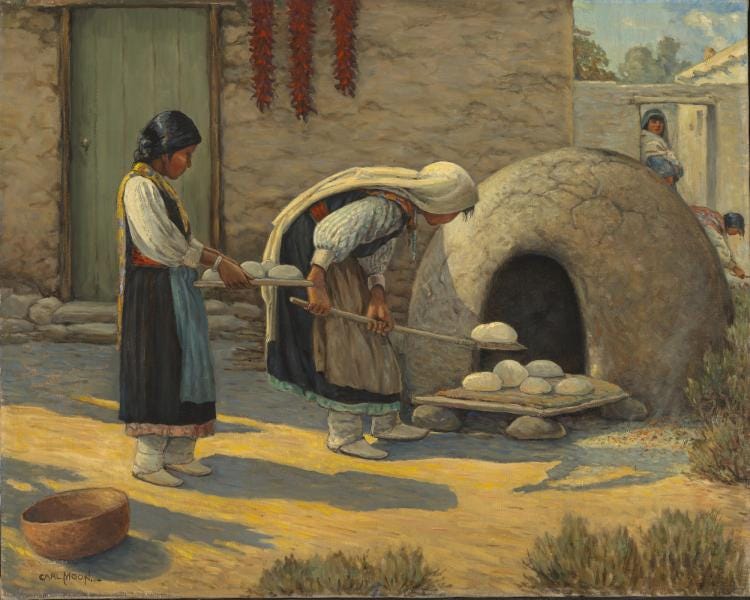#4 | Pulling Sourdough Apart & Other News
Separating sour dough from sourdough, a last Sunday dinner, and the cogs of fine dining
Hello. Thanks for being here.
This is the fourth edition of In Digestion, a weekly survey of the best food media on the web, and why you should care about it. If you like this newsletter, please follow @in_digestion on Twitter, and forward it to a large number of people. It should feel like too many. It won’t be enough. Thank you.
Carl Moon | Smithsonian American Art Museum
Writing about food and writing about food writing feel somewhat callously indulgent right now. In lieu of an intro, if you are in a position to support the funds linked below, please do.
https://minnesotafreedomfund.org/





Dayna Evans and Bryan Ford unshackle sour dough from sourdough for Taste. For something that relies on rising, sourdough culture has always felt somewhat flattening; erasing difference in favour of homogeny in the same way that “speciality coffee” tries to present itself as a transcultural good. Evans describes Ford’s approach as “taking the concept of sourdough and burning it all down,” but it feels more like a prising apart of the word, opening up a space that mainstream, white bread culture would prefer to hide. “Ethiopian injera is sourdough, Indian dosa is sourdough, Sri Lankan hoppers are sourdough, Sudanese kisra is sourdough. Technically speaking, any fermented bread made between roughly 3,700 BC and the invention of commercial yeast in the 1800s” is sourdough. Pair with Evans’ seminal piece on the rise of the bread bro, for Eater. [Disclosure: I am associate editor at Eater’s London branch.]
Leslie Lamar Parker has one last Sunday dinner for The Counter. Leslie Lamar Parker died of coronavirus on 11 May 2020. In the context of this devastating news, his memory of Sunday dinner, which itself starts with the death of great-grandmother, becomes a poignant fragment of self-obituary. Funny and sharp — “when I proposed a supper without technology, they unionized and planned a walkout” — Parker captures how Sunday dinners have changed and stayed the same through prime ribs and green beans, bitter wine and apple cider, and through a pandemic: “I won’t recall how unforgiving the virus was to people like me. I won’t talk about how scared I was for my wife, who has severe asthma. If I’m lucky, I won’t have to say goodbye to somebody close to me. Instead, I’ll remember the conversations we had during our Sunday dinner.” Its final words take on an eternity:
Now that I think about it, maybe I am still sitting at that kid’s table in Little Mama’s three-bedroom townhouse on 84 1/2 Avenue, North. Maybe I’m still eating that same Sunday dinner, after all.
Esther Tseng reports COVID-19’s disproportionate impact on undocumented workers for Civil Eats. Best paired with Patricia Escárcega’s account in the LA Times, Tseng lays out the discrepancy between the burden of work and risk placed on undocumented workers and their recourse to support and resources: “they’re largely invisible to the dining public. In reality, they’re the backbone of the industry. And yet, many are unable to obtain health insurance even though they perform backbreaking work day after day. Most didn’t receive a $1,200 stimulus check from the government, and they often fear getting tested for COVID-19 or obtaining care for fear of deportation.” It’s another indictment of the false recasting of workers as essential, whose hidden antithesis is that they were, are, and will be treated by a system that relies on their exploitation as disposable. You cannot renovate a burning house.
Samuel H. Yamashita turns the cogs of cultural shifts in “fine dining” for Gastronomica. Yamashita lays out what he calls “the Japanese turn,” which arcs from lionised French chefs “refusing to discuss” Japanese influence to a “reimagining of fine dining” that anchors itself to Japanese ingredients, techniques, and meal structures. Documenting chefs coming to Europe and returning to Japan to bend and break calcified French norms, Yamashita weaves the progression into the dominance of nouvelle cuisine, and clearly lays out its regional textures across the USA and France. Read in the context of Meghan McCarron’s seminal piece on the same subject, for Eater.
Rachel Roddy goes back to a restaurant in Rome on The Kitchen Is on Fire. Roddy, who lives in the city and writes about how its food is also its history and its spaces, discusses the reopening of restaurants and the importance of safety before culinary pleasures of “fried anchovies and breadcrumbed fish.” She also remembers the formative experience of her grandmother’s Manchester pub, and the responsibilities of telling a city’s stories that are not her own.
An interview with Rachel Roddy on that discussion, its resonances, her wider work, and its relation to food media will be the fourth paid post on In Digestion, going out 03 June. Thank you again for being here.
That’s all for this week. Before the next edition, why not read this and digest it, consider the privilege of failure, or subscribe to The Kitchen Is on Fire. Oh, and please forward this to that large number of people. Or just, like, everyone.



